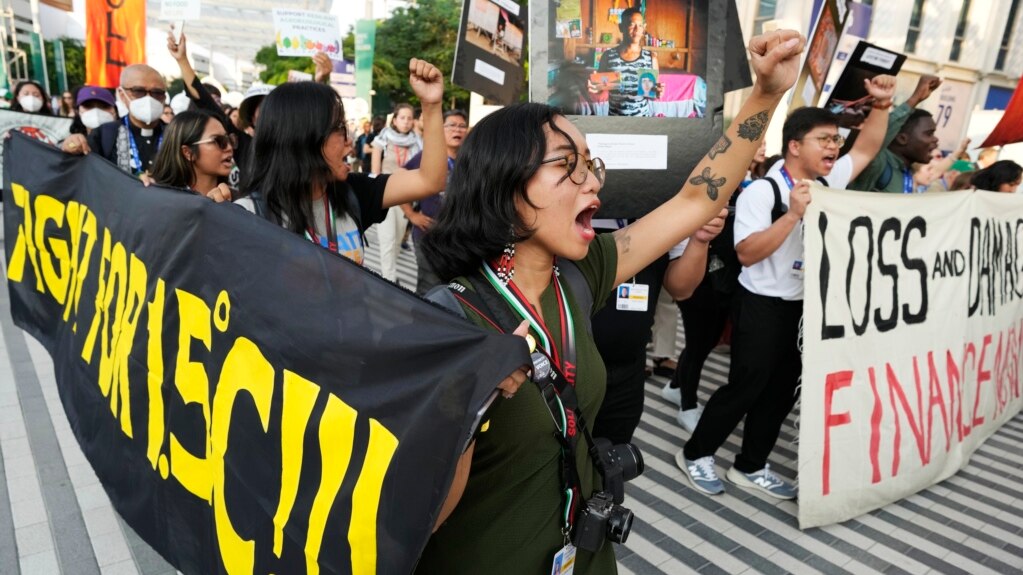United Nations delegates from nearly 200 countries recently held a climate meeting in Dubai, United Arab Emirates.
The delegates agreed that the world must move away from fossil fuels like oil, gas, and coal.
The U.N. meeting on climate change is called COP28 this year. Recently, The Associated Press gave details about some of the main results of notable climate talks over almost 30 years:
The Kyoto Protocol
The Kyoto Protocol was the third high-level U.N. climate meeting. It took place in Kyoto, Japan in 1997.
The agreement asked 41 countries that produced a lot of carbon gases to cut their emissions by about five percent compared to their emission levels in 1990.
Countries agreed to some of the terms in the Kyoto Protocol by 2005. The United States and China, however, did not approve the agreement. Those countries have the world’s two largest economies and produce the largest amount of carbon gases.
The Kyoto Protocol was not successful by some measures. Emissions have greatly increased since then. But it is the first time so many U.N. members agreed that carbon gases were a problem.
Copenhagen’s money for the climate
The 2009 climate meeting in Copenhagen, Denmark is widely seen as a failure. Developing and developed countries disagreed on cutting emissions and whether poor nations could use oil, natural gas, and coal to grow their economies.
However, wealthy countries promised to send $100 billion a year to developing countries. The money was to be used for green technology by 2020. Green technology often describes energy technology that does not produce pollution when it is used.
But wealthy nations did not reach their goal of $100 billion by the start of the 2020s. That led to criticism from developing countries and environmentalists.
In 2022, the Organization of Economic Cooperation and Development, an international economic group, said wealthy countries probably reached their $100-billion goal.
But the British nonprofit group Oxfam said 70 percent of the money was in the form of loans. It said the loans increased debt problems in developing countries.
Also, an increasing number of weather-related disasters are blamed on climate change. Experts say the money promised is not enough. British economist Nicholas Stern said that developing countries likely need $2 trillion every year by 2030 for climate projects and recovery.
The Paris agreement
The Paris Agreement is widely considered the single biggest U.N. agreement on climate change. In 2015, about 196 nations agreed to keep atmospheric warming “well below” 2 degrees Celsius since, what the agreement calls, “pre-industrial times.” Later, the goal became limiting warming no higher than 1.5 degrees Celsius.
The U.N. says the Paris agreement is a “legally binding international treaty,” meaning that it has the force of law in countries that approve it. But there do not appear to be punishments for countries that do not follow its rules.
Today, the goal of limiting the rise of the atmosphere’s temperature to 1.5 degrees is still central to climate discussions. U.N. experts say the world’s temperature has not passed the limit set in the Paris agreement. The U.N. says it has warmed from 1.1 to 1.2 degrees Celsius since the early 1800s. But it says the atmosphere will reach the 1.5-degree limit soon unless large cuts in emissions are made quickly.
Glasgow and coal
Six years after the Paris agreement, climate officials wanted another agreement to strengthen the levels agreed upon in 2015.
The meeting in Glasgow, Scotland was put off until 2021. It was delayed by the COVID-19 pandemic. The meeting included protests led by teenaged climate activist Greta Thunberg. She helped lead a worldwide movement of youth activists demanding more action from leaders.
In Glasgow, countries agreed to “phase-down” coal use. That is different from saying “phase-out.” India and China, two of the world’s biggest coal users, pressed for the change.
So far, most countries have failed to meet the promises they made at the Glasgow deal. Emissions from coal have increased and most major coal-using countries have yet to slow use of the fuel.
Loss and damage in Sharm el-Sheikh
Last year, climate talks took place in the Egyptian vacation town of Sharm el-Sheikh. There, countries agreed to create a fund for poor nations for the first time.
Delegates agreed to a loss and damage fund. Its aim was to provide money to countries that suffered damage from severe weather events.
Delegates at the COP27 meeting called for the fund to be created after a flood in Pakistan killed an estimated 2,000 people and caused billions of dollars in losses.
The fund was officially created on the first day of this year’s talks in Dubai. Over $700 million has been promised. Giving to the fund is voluntary.
U.N. climate experts say billions of dollars are needed because of weather-related events like cyclones, rising sea levels, floods and droughts. The experts blame the extreme events on increasing temperatures in Earth’s atmosphere.
I’m Gena Bennett. And I'm Gregory Stachel.

